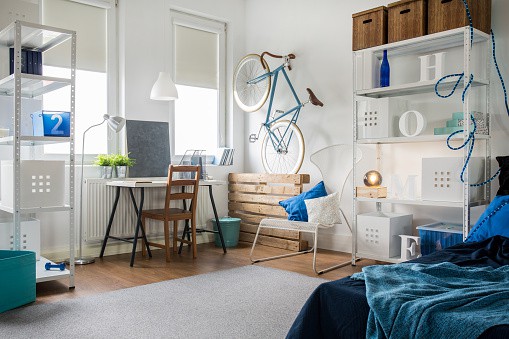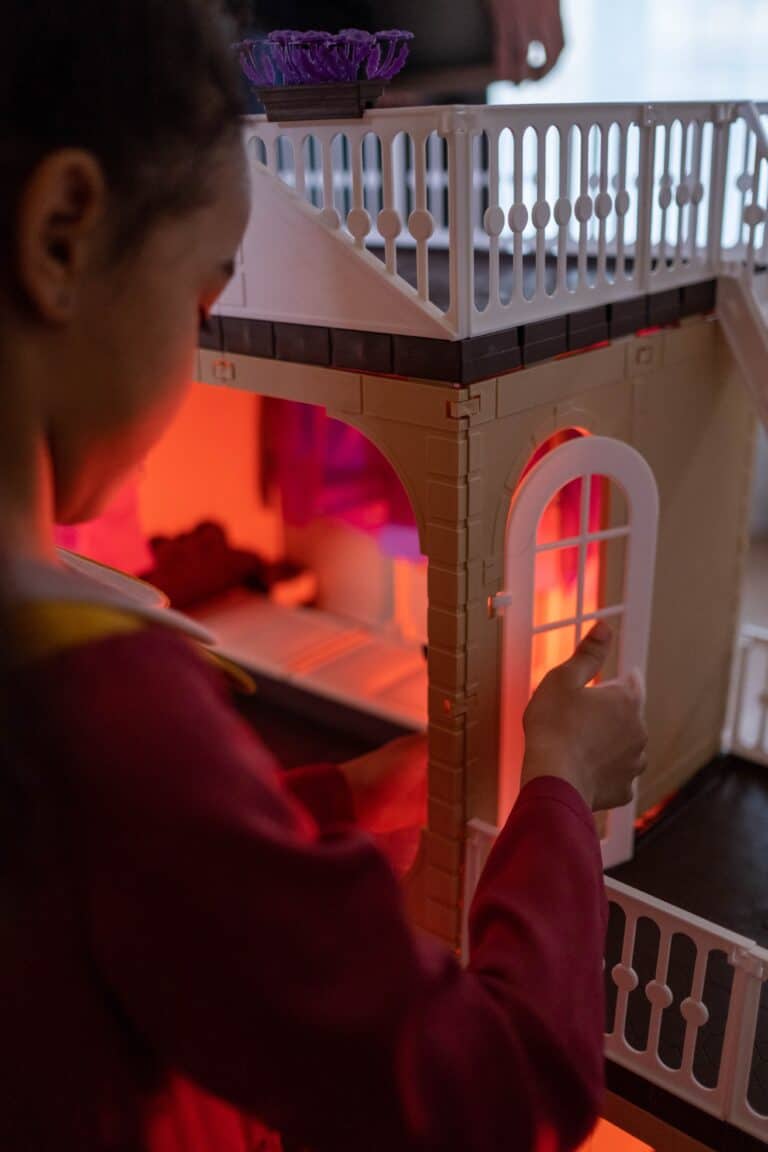Unique Split Level Home Remodel Ideas to Transform Spaces
Ever peered at your split level home, scratching your head in wonder about how to transform it into a space that truly reflects you? Well, you’re not alone.
The first house we ever lived in was a split-level home as well as a fixer-upper. In the grand design game of life, split-level homes often pose a unique set of challenges – and opportunities! With their distinctive multi-level layouts, they open up a world ripe for creative remodeling.
Picture this: A modern open floor plan breathes new life into what was once segmented living spaces. Your basement transforms from an overlooked storage area to functional square footage adding value to your property. The right exterior color choices turn heads as they boost curb appeal significantly.
Let’s tackle these challenges head-on and uncover the hidden potential in our cherished split levels. We’re about to explore practical Split Level Home Remodel Ideas. So, get ready because
Table Of Contents:
- History of Split-Level Houses
- Understanding Split Level Homes and Their Unique Features
- Benefits of Remodeling a Split Level Home
- Enhancing the Main Living Areas
- Creating an Inviting Atmosphere
- Maximizing the Use of Space
- Modernizing the Interior
- Overcoming Design Challenges
- How To Improve a Split Level Home
- The Unique Challenges of a Split Level Home
- A Modern Approach to Floor Plans
- FAQs in Relation to Split Level Home Remodel Ideas
- Conclusion
History of Split-Level Houses
If you’ve ever watched the popular sitcom The Brady Bunch, then you’re already familiar with the charm and functionality of split-level houses. These unique home designs first made their mark in American suburbs during the 1950s and 1960s, serving as a refreshing variation from traditional ranch homes that dominated housing styles since the roaring twenties.
Their popularity soared in the 1970s, primarily because they offered an innovative solution to maximize square footage on smaller plots. This made them more affordable – a huge selling point for America’s burgeoning middle class at that time.
A Slow Decline but Resilient Existence
However, like all trends, split-level homes experienced a decline when larger home constructions took center stage during the 1980s and 1990s. Nowadays, it’s quite rare to find newly constructed split-level homes; yet many original ones continue to grace our neighborhoods with their distinctive style.
Versatile Designs That Still Charm Today
Also known as raised ranches, these multi-story dwellings are characterized by staggered floor levels – typically three but can go up to five levels! Unlike conventional houses where each level stacks upon another uniformly, split-level residences feature two short sets of stairs: one leading upward towards bedrooms while another descends into basement areas.
In simpler terms? If your house has half-split staircases or shorter flights of stairs between floors rather than long continuous ones — congratulations! You’re likely living in a classic example of this mid-century architectural innovation!
No One Floor Rules Them All
An interesting fact about these types is that no single floor covers the entire footprint of the house. This design quirk not only adds to their charm but also provides unique opportunities for space utilization and interior décor.
Whether you’re looking to remodel your split-level home or simply appreciate its historical significance, understanding its roots can provide a wealth of inspiration. So embrace those quirky stairs and half-floors – they are part of what makes your home uniquely yours!
Understanding Split Level Homes and Their Unique Features
If you’re in the market for a home with character, split level homes might just be your ticket. They are known for their multi-level design that gives them an unmistakable mid-century modern appeal.
A classic split level house tour will reveal several distinct levels, each serving its unique purpose. Unlike traditional ranch homes or other single-story dwellings, these quirky constructions offer homeowners various opportunities to get creative when it comes to remodeling.
You see, despite their charmingly retro vibe, split level homes come with a set of challenges – but also potential rewards – when it’s time for renovation projects. According to our research (Research 2), these obstacles can turn into exciting possibilities if approached correctly.
The Magic of Multi-Level Design
In typical split-level houses (or should we say “level houses”?), there is usually a main floor containing common areas like the kitchen and living room while bedrooms occupy another tier entirely. These different zones provide privacy without needing additional square footage—a clever trick indeed.
Falling For Split Levels
We won’t deny that some folks find the stairs inconvenient in these types of abodes—but hey. You could think about it as built-in cardio. And let’s not forget how those staggered floors can give us beautiful sightlines across multiple spaces within the house—especially attractive if open-concept living tickles your fancy.
The Unmistakable Mid-Century Modern Charm
No discussion on this topic would be complete without touching upon their inherent mid-century modern charm. After all, most split-level homes were born during this era—so they naturally ooze that ‘Mad Men’ aesthetic we’ve all come to love. It’s always enjoyable to inhabit a residence with its own distinctive story.
Unleashing Your Creative Potential
The real magic happens when you start seeing the potential for remodeling within these spaces. The distinct levels offer unique opportunities for creative spatial arrangements and design interventions.
Ready for a bit of excitement? Loads of split-level remodel ideas are out there, just begging to be found.
Split-level homes are a gem, boasting multi-tiered design and a dash of mid-century modern appeal. Sure, they might pose some hurdles during renovation, but that’s where your creative juices come into play. Think spatial layouts and innovative designs. Don’t view the stairs as an obstacle – see them as built-in cardio. Seize this opportunity to stamp your personality on these delightfully vintage spaces.
Benefits of Remodeling a Split Level Home
By remodeling a split level property, you can take advantage of increased property value and improved functionality.The most obvious benefit of remodeling a split level home is you can literally split up your budget and redesign or remodel one level at a time.
Embracing Open Floor Plans
The beauty of a split level remodel lies in its flexibility. One popular way homeowners choose to modernize is by creating an open floor plan – essentially turning separate rooms into one large living space.
This approach makes smaller spaces feel larger and encourages family interaction. According to research, knocking down walls between the kitchen and dining, which is what we did, is becoming increasingly popular as people seek more open spaces within their homes.
You may be asking yourself how such a significant change could benefit you. Well, let’s look at some specific advantages associated with embracing an open floor layout during your split level remodel project:
- Better Flow: An open design allows easier movement throughout different areas of your home which means less time spent navigating through doors or hallways.
- Increased Natural Light: Fewer walls mean more windows. The result? A bright airy atmosphere filled with natural light enhances mood and saves energy costs.
- Social Engagement: Cooking dinner while chatting up guests lounging in the living room becomes easy-peasy thanks to the lack of partitioned rooms. It promotes socialization even during mundane chores.
Improving Property Value Through Renovation
Apart from lifestyle perks, there are economic benefits too. As per real estate trends, data collected over the years show clear indications that houses with open floor plans often fetch a higher market price. So, your remodeling split level project is not just about modernizing aesthetics but also making smart financial decisions.
However, remember to approach this journey of transformation armed with well-thought-out split level remodel ideas. A clear vision will help you create an abode that’s both functional and stylish without going overboard on the budget.
Aesthetic Upgrades: Not Just About Walls
Walls are essential elements in forming the environments we inhabit and toil in.
Revamping a split-level house isn’t just about sprucing up its looks—it’s also an investment in your property. Modern renovations often favor open floor plans, which can enhance the flow between rooms, boost natural light and foster better social interaction. This change not only lifts your home’s value but also crafts a practical yet chic living space. Just keep in mind to tackle this adventure with clarity.
Enhancing the Main Living Areas
Making the most of your main living areas is essential if you are a split-level home dweller. Creating a comfortable atmosphere that feels like home is the key to making your main living areas inviting.
Optimizing the Dining Room
The dining room often acts as a social hub for family and friends. So, you can take down those walls separating the kitchen from the dining area according to this guide on removing load-bearing walls between rooms. This allowed you not only to create a massive open space but also helped bring more light into these previously closed-off areas.
You may ask: “But wouldn’t that affect my house structure?” Well, if done correctly and with proper help, it can actually be quite safe. In fact, it gave us much-needed freedom when rethinking our floor plan layout. But always remember safety first.
This change will completely transform both spaces into one cohesive unit which makes them feel significantly larger than they were before – sort of like magic.
Finding Balance in Your Living Space
Making such drastic changes can seem daunting at first glance. But don’t fret. As long as there’s balance within your newly opened-up living area things will fall perfectly into place.
A good tip is dividing up your open-concept space using furniture arrangements or color schemes; effectively marking where one ‘room’ ends and another begins without resorting back to those physical barriers (remember those old kitchen-dining room walls?). Creating visual boundaries while maintaining openness does wonders for preserving functionality whilst giving off an airier vibe.
Comfort is Key in the Living Room
The living room should be a place of relaxation and comfort. A well-placed, comfy sofa can set the tone for the entire space. It’s all about creating an atmosphere that invites you to sit down, kick off your shoes, and stay awhile.
Our advice? Splurge a bit on top-notch furniture. Go for stylish, comfy pieces like plush sofas decked out with loads of throw pillows.
Revamp your split-level home’s main living areas by breaking down walls, letting light in, and creating open spaces. Use furniture arrangements or color schemes to define zones within the open-concept layout while maintaining a spacious feel. Invest in high-quality, comfortable pieces for your living room – they’re worth it.
Creating an Inviting Atmosphere
The first impression is everything. The exterior of your split-level home sets the tone for what’s inside, so it should exude charm and warmth. But how do you boost that all-important curb appeal? Well, one effective way to make a statement is through color.
Choosing the Right Exterior Color
A fresh coat of paint can work wonders on any house exterior. It’s like getting a new outfit – suddenly you’re turning heads. But when it comes to split level exteriors, picking the right shade can be more challenging than solving a Rubik’s cube blindfolded.
Don’t worry though; we’ve got some tips up our sleeves. Firstly, consider shades that complement your home’s architectural style and era – remember this isn’t just about personal taste but also historical context.
You might want to look at earth tones if your split-level has mid-century roots or perhaps go bold with contemporary hues if modernization tickles your fancy. Think less chameleon trying to blend in and more peacock flaunting its feathers. Here are some winning color schemes.
In fact, updating the exterior of a split level home can greatly enhance its curb appeal (Research 2).
Landscape Your Way into Their Hearts
No matter how eye-catching your paint job is, without good landscaping, even Cinderella would fail her royal ball entrance test. Here too there are no rules set in stone (pun intended). From manicured lawns graced by English roses to rock gardens featuring hardy succulents – a variety spices things up.
Raise the stakes by using outdoor lighting to highlight key features and make sure your home is just as stunning after sunset. Consider how different elements such as walkways, fences or shrubs can be used to frame your split-level’s unique structure.
Give Your Entrance Some Love
Don’t forget about the entrance of a split-level home. It’s like your resume’s cover letter, grabbing attention right off the bat. A chic door with potted plants or topiaries on either side can make it feel really welcoming.
Boost your split-level home’s curb appeal with a fresh coat of paint in colors that highlight its architectural style. Complement this makeover with well-planned landscaping and strategic outdoor lighting to showcase key features, even after sunset. Lastly, spruce up the entrance like it’s your home’s cover letter – chic and welcoming.
Maximizing the Use of Space
The basement in a split level house often gets overlooked. It’s time to rethink the potential of your basement. Transforming your basement into a functional space is like finding hidden treasure right under your feet. It adds valuable square footage to your home, which increases its overall value.
Transforming Your Basement into a Functional Space
We’ve all been there: You’re standing in an unfinished basement and imagining what it could be. Visualize how you can utilize this additional area as an expansion of your way of life. Instead, think of how you can use this extra room as another extension of your lifestyle.
If you love hosting gatherings but feel constrained by limited space upstairs, consider turning part of the basement into an entertainment area with a bar or gaming zone. Or if you have children who need their own playroom or study area away from distractions, carve out a portion for them too.
Your laundry room might currently be tucked awkwardly between two other rooms on one level; relocating it downstairs will make life so much easier – no more carrying heavy baskets up and down stairs. And let’s not forget about guests – imagine offering them their private suite complete with small bathroom instead of cramming everyone together when they visit.
You see? The possibilities are endless once we start looking at our basements differently.
Finding Balance Between Functionality & Aesthetics
Basements tend to get dark due to a lack of natural light and low ceilings compared to upper levels. But fear not. With careful planning, even these challenges can turn into unique design features.
- Add some fun wall sconces or a couple of stylish pendant lights to create mood lighting.
- Opt for light-colored walls and flooring to bounce off the available light and make the room seem brighter.
- Add rugs, wall art, and mirrors – all these help in creating an inviting atmosphere that makes your basement feel like another level of your home rather than just ‘the basement’.
Let your creativity loose—it can truly work wonders in sprucing up this often-overlooked area. Don’t hesitate to experiment.
Revamp your split-level home by tapping into the potential of your basement. Transform it from an overlooked space to a functional area that reflects your lifestyle and needs – be it for entertainment, kids’ study room, laundry or guest suite. Balance functionality with aesthetics by incorporating clever lighting options, light-colored decor, and engaging wall art to create an inviting atmosphere.
Modernizing the Interior
Unveiling a modernized interior can be an incredibly rewarding experience. It’s not just about slapping on some new paint or installing fancy fixtures – it’s about creating spaces that are both functional and stylish.
Giving Your Bathroom a Modern Makeover
Let’s start with one of the most essential rooms in your split-level house: the bathroom. Although diminutive in size, bathrooms contain immense possibilities for alteration.
The small bathroom in our project house, for example, was completely gutted and transformed. What was once cramped and outdated is now an oasis of calm where anyone would love to soak after a long day.
A Touch Of Luxury In the Kitchen Remodel
Moving onto another crucial space – your kitchen. A sleek kitchen remodel can dramatically change how you use this central hub of activity. Think contemporary cabinetry coupled with energy-efficient appliances set against tastefully chosen backsplash tiles – sounds tempting, doesn’t it?
In our split level project home we opted to take down walls between the dining room and kitchen area, thus opening up these zones into one unified living space which echoes popular trends seen in many modern houses today.
Crafting Cohesive Design Throughout Your Home
Remember though; when modernizing interiors consistency is key. Don’t let any part feel left out from all those awesome upgrades happening around them.
| Steps to Modernizing Your Split Level Home | |
|---|---|
| 1. | Tear down walls between the kitchen and dining room for a unified space (Research 1). |
| 2. | Gut and remodel small bathrooms into functional, stylish spaces (Research 1). |
Modernizing your space opens up a world of endless potential. Whether you’re updating old bathroom fixtures or giving your split-level home a complete makeover, the possibilities are limitless.
Transforming a split-level home isn’t just about fresh paint or new fixtures. It’s about crafting functional, stylish spaces like modern bathrooms and open-plan kitchens. Consistency is key when remodeling – every room should feel part of the transformation journey. Remember, updating your home unlocks endless potential.
Overcoming Design Challenges
When it comes to split-level homes, the unique layout can often present some interesting design challenges. But don’t fret. Don’t be daunted by the design issues that arise from a split-level home; instead, take it as an opportunity to exercise your creativity.
The first thing that typically trips people up is lighting. Split level houses have a notorious reputation for being somewhat dark due to their multi-layered structure. This is where our friend’s recessed lighting swoops in like a superhero with a cape made of lightbulbs.
Add Recessed Lighting For A Modern Look
You see, recessed lighting not only improves the overall brightness but also contributes significantly towards giving your home that modern look everyone craves these days (we’re looking at you, mid-century modern enthusiasts). Our research shows adding this type of lighting can give your space an instant face-lift.
A great place to start incorporating recessed lights could be the kitchen or living area; essentially any part of your house where folks tend to gather most. Remember though – always consult with a professional before taking on such tasks yourself.
Tackle The Staircase Challenge Head-On
Moving onto another quirk specific to split levels: staircases – oh boy. Often awkwardly placed right smack dab in the middle of everything else (really architects?), they can make furniture arrangements more than just tricky.
To overcome this hurdle, try using smaller pieces around staircase areas instead of bulky ones which would otherwise take up too much room and disrupt flow within the house. Another pro-tip? Consider installing built-in storage under those stairs – functional and stylish.
Embrace The Levels, Don’t Fight Them
Last but not least, one of the most significant challenges homeowners face is dealing with those different levels. They can sometimes feel disjointed and interrupt the overall flow.
The key here? Embrace it. Use each level to define a specific purpose or function. For example, turn that lower-level into an awesome game room or cozy den – complete with vinyl plank flooring.
Create Visual Continuity With Color And Materials
For a smooth visual flow, it’s essential to…
Embrace the unique layout of split-level homes and flex your creativity. Brighten spaces with recessed lighting, optimize furniture placement around central staircases and use built-in storage for a sleek look. Assign each level a distinct purpose for an engaging home experience while maintaining visual continuity with color and materials.
How To Improve a Split Level Home
If you’re like me and have just purchased your first split level home, congratulations! You’ve probably spent countless hours dreaming about the potential of every room. Let’s face it – most split-level homes are stuck in their original 1970s finishes. But don’t fret; there are numerous ways to bring these homes into the 21st century.
The Unique Challenges of a Split Level Home
Renovating a split level home is no easy task. These houses come with their own unique set of challenges that aren’t typically found in new construction or basic ranch-style houses. For instance, while the lower level may be built on a concrete pad, the mid-level might sit atop a crawl space – talk about having your work cut out for you!
But fear not: these obstacles can actually turn into opportunities if approached correctly. The variety of scenarios one encounters when renovating such homes offers an enriching learning experience that makes the renovation journey all the more rewarding.
A Modern Approach to Floor Plans
An effective way to modernize any old-fashioned house is by opening up its floor plan – this applies especially well to our beloved split levels from yesteryears where open plans were less popular.
To do so safely without tearing down load-bearing walls (trust me, you don’t want to go there), I recommend checking out your attic for bracing connections between wall top plates and rafters as an indication of load-bearing walls before swinging that sledgehammer around.
- Create Open Spaces: By knocking down non-load bearing walls wherever possible, we can create a more open, airy feel in the home.
- Update Finishes: Replace outdated finishes with modern ones to give your split level home an instant facelift.
Remember: every challenge encountered during this process is just another opportunity for growth and learning. Embrace it!
FAQs in Relation to Split Level Home Remodel Ideas
How do you modernize a split-level home?
You can modernize a split-level home by opening up the floor plan, updating exterior colors, and transforming small bathrooms into functional spaces.
Can you remodel a split-level?
Absolutely. Remodeling a split level not only improves its functionality but also boosts property value significantly.
How do you add value to a split-level house?
Add value to your house by enhancing main living areas, boosting curb appeal, finishing basements for extra square footage, and overcoming design challenges creatively.
What can you do with a split-level house?
Innovative remodeling ideas like optimizing dining rooms or adding recessed lighting make the most of unique features in your split level home’s multi-tier structure.
Conclusion
Revamping your split level home doesn’t have to be a daunting task. From embracing open floor plans to enhancing main living areas, there are countless ways to bring new life into these unique spaces.
You’ve discovered how choosing the right exterior color can drastically boost curb appeal. And how transforming underutilized basements and bathrooms contributes significantly towards maximizing space and modernizing interiors.
Navigating through design challenges is part of the journey, but with these practical Split Level Home Remodel Ideas, you’re well-equipped for success!
The world of split levels awaits – time to make those remodeling dreams come true!







